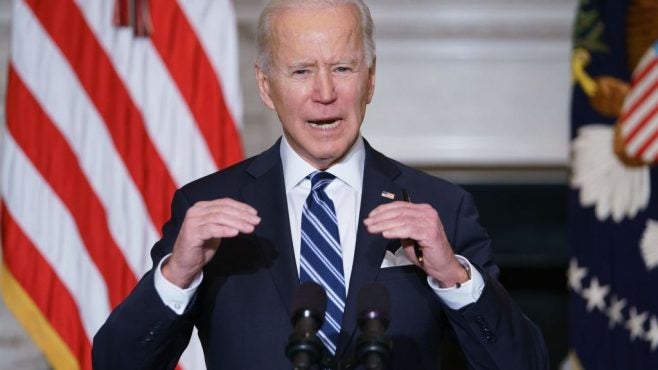Donald Trump was a wrecking ball who laid waste to the notion that the US is a responsible actor that honours global commitments. On arms control, climate, human rights, nuclear proliferation and so much more, Trump’s “America first” zealotry pushed his administration to abandon the US’s international obligations. This week’s White House climate leaders’ summit is an opportunity for Joe Biden to begin to undo that damage and show the world the US is ready to raise its climate ambition.
A total of 40 world leaders, including Chinese President Xi Jinping and German Chancellor Angela Merkel, are invited to participate in the virtual summit on 22–23 April 2021. The White House has been careful not to raise expectations, despite efforts by Biden’s indefatigable, globe-hopping climate envoy John Kerry to cajole other countries to announce more ambitious targets either at the Earth Day summit or ahead of COP26, to be held in Glasgow this autumn.
If leaders who join the summit decide to make flashy announcements, the White House will consider it a bonus. All involved know the most anticipated words will be those spoken by Biden when announcing the US’s new 2030 greenhouse gas emissions reduction target. Advocates, civil society, and local and state officials have called on the White House to establish a target to reduce emissions by at least 50% from 2005 levels by the end of the decade. Anything less will be a disappointment.

If Biden lives up to this ambition and submits such a target to the UN as part of the US’s updated nationally determined contribution (NDC) under the Paris Agreement, it would be among the most demanding put forward by an advanced economy, finds the Rhodium Group, an independent research firm.
Rhodium Group researchers recently compared a potential 50% 2030 US emissions reduction target with those announced by other advanced economies, including the UK, EU, Japan and Australia. When assessed against a 2005 baseline, the US would be among the top four most ambitious 2030 commitments, says Rhodium Group’s Kate Larsen. “A 50% US NDC would also catapult it far beyond its current 2025 target of 26–28% below 2005 levels,” she says.

US Tariffs are shifting - will you react or anticipate?
Don’t let policy changes catch you off guard. Stay proactive with real-time data and expert analysis.
By GlobalDataEarlier analysis by the organisation found that US greenhouse gas (GHG) emissions declined by an estimated 10.3% in 2020, pushing the country’s emissions below 1990 levels. However, the researchers cautioned these results, caused in part by Covid-19-induced economic calamity, “should not in any way be considered a down payment” towards the US meeting its 2025 target. “Without meaningful structural changes in the carbon intensity of the US economy, emissions will likely rise again,” they wrote.
Actions by the Biden administration during its first 100 days in office reflect the White House’s desire to achieve that structural change. The president has assembled an experienced senior climate and energy team and rejoined the Paris Agreement. He has tasked federal agencies with identifying Trump-era actions to undo, writing new rules to slash emissions from vehicles and oil and gas facilities, and encouraging more efficient appliances. He has set a target to build 30GW of offshore wind power capacity by 2030 and released a $2.25trn infrastructure and jobs proposal that allocates $1trn to climate and clean energy. This figure is more than ten times what was spent on clean energy in the recovery package passed in response to the Great Recession during the Obama administration.
[Keep up with Energy Monitor: Subscribe to our weekly newsletter]
Still more announcements are expected ahead of this week’s summit. The White House is believed to be drafting an executive order to address climate-related financial risks across federal agencies. Also rumoured to be in the works is an administration pledge to slash methane pollution.
Biden can be bold because the political winds are at his back. Large majorities of Americans – Democrats and Republicans alike – support renewable energy, and many of the US’s largest corporations want the White House to ramp up its ambition ahead of this week’s climate summit. More than 300 businesses and investors, including Apple, Google and Walmart, are calling on Biden “to adopt the ambitious and attainable target of cutting GHG emissions by at least 50% below 2005 levels by 2030”. Likewise, 13 power companies are urging the administration to adopt a clean energy standard to ensure electricity emissions decline by 80% below 2005 levels by 2030.
Joe Biden’s early words and deeds have signalled to the world that the US is once again ready to help lead the global effort to combat the climate crisis. Sceptical countries want to hear and see more from Biden, including a firm commitment to make good on the $2bn the US still owes the Green Climate Fund. However, nothing Biden could say later this week would do more to demonstrate US resolve than announcing a 2030 emissions reduction target as aggressive as science demands.




